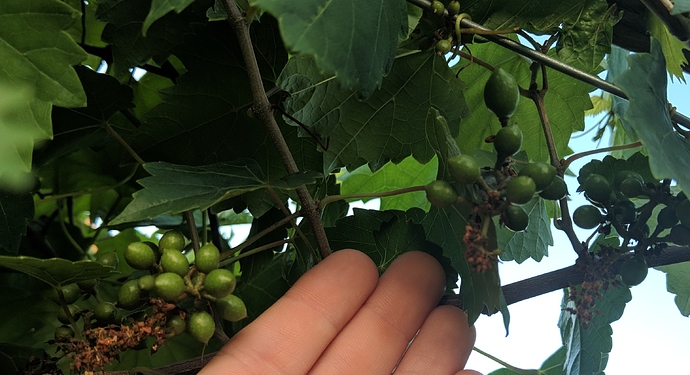Thinking of especially the american hybrid grapes and good types of muskadines…
Any of yall growing the old Munson wild selections or any american hybrids?
Have you found them no-spray?
Above average disease resistant?
Productive?
Drought hardy?
Does black rot affect yours?
Here is a hybrid description:
Wetumka: "Type = American Hybrid. Per Hedrick (see citation): “Of medium vigor, healthy, productive; stamens erect; clusters medium, ovate, moderately compact, sometimes shouldered; berries large, globular, yellowish-green; pulp juicy, tender; good; ripens after Concord.” Per Munson (see citation): “Growth medium, healthy, withstands mildew and rot well. Clusters medium to large, ovate, sometimes shouldered; peduncle medium; berries large, globular, persistent, yellowish-green; skin never cracks; pulp juicy; tender, freeing the seeds easily; quality better than Niagra. Ripe late after Concord is off. Bears heavily on short arms. A profitable market and table grape and will make an excellent white wine. Eight feet. Adapted for the South, and same range as Gold Coin, Texas to Missouri.”
Extra:"= American Hybrid. Per Munson (see citation): “Growth strong; cluster oblong to cylindrical, sometimes shouldered, moderately compact. Berries persistent, globular, medium to large, dark purple to black, with moderate bloom, skin thin, tough, never cracks; pulp tender, juicy, sprightly, agreeable, sweet; seeds easily passing from the pulp. Ripe July 25 to August 10 at Denison. Does well in South Texas. An excellent market and wine grape.” Per Hedrick (see citation): “Vigorous, healthy, productive; cluster large, usually shouldered, compact; berry medium to large, dark purple or black; good in quality in the South; does not mature at Geneva.”
Gold Coin: " = American Hybrid. Per Bushburg Catalogue (see citation): “Vine vigorous, late in leafing, shedding leaves and flowering, very hardy and productive, flowers perfect; clusters medium, berry medium to large, persistent, rich golden yellow when fully ripe, rarely touched by rot; skin thin but tough, pulp not tender, yet juicy of agreeable flavor, becoming very sweet when fully ripe. A showy market grape and will make a very good white grape.” Per Munson (see citation): “Growth medium. Cluster medium or above, ovate shouldered, proper degree of compactness. Berries large globular, yellowish when fully ripe, persistent; skin thin, touch, never cracks, and rarely attacked by rot; pulp about the same consistency as Concord, very juicy and exceedingly sweet; retains a little of Martha flavor; liked by most persons. Very handsome in the basket and markets excellently. Requires good soil cultivation and fertilization to maintain its vigor.” Per Hedrick (see citation): “Vine medium to vigorous, hardy, produces heavy crops. Leaves medium to above in size. Fruit ripens after mid-season, keeps long in good condition. Berries large to below medium, roundish to slightly oval, yellowish-green with a distinct trace of reddish-amber, covered with a medium amount of gray bloom, usually persistent. Skin covered with small scattering brown dots, thin, inclined to toughness. Flesh somewhat tough, faintly aromatic, tart from skin to center, good in quality.”
Etta: " American Hybrid. Per Bushburg Catalogue (see citation): “Resembles Elvira, with firmer skin, not disposed to crack, and is of very good quality. It ripens later. The vine is of very vigorous growth with strong, healthy foliage, hardy, and productive.” Per Our Native Grape, pg. 134: “A seedling of Elvira, introduced by Jacob Rommel. It is an improvement of Elvira in quality, larger berries with firmer skin; not so compact or crowded in bunch; not so liable to crack and free from rot; vine healthy, strong grower, very productive; ripens after Concord.”
Krause: "American Hybrid. Per Munson (see citation): “Vine vigorous, slightly attacked by mildew in damp seasons, prolific; cluster large, shouldered; berries large, globular, pearly white, handsome, skin thin, tough, pulp tender, melting, of fine quality, little attacked by rot, a valuable market and table grape, for the South, north to Kansas and Kentucky.” Accession also mentioned by Hedrick (see citation).
Carlos: "A yellow muscadine, sweet and self-fertile with a pleasing flavor. No spraying or bagging of fruit clusters needed. Native. The most widely planted yellow muscadine in North Carolina. Space 4’ x 8’, trellis 6’ tall. Zones 7-9.
Ison’s: "Is an early ripening muscadine grape. Ripens yearly at the nursery with no insect or disease spraying. Large black sweet fruit with tart skin. Very, very disease resistant. Self fertile. Native Space 4’x 8’ trellis 6’ tall. Zone 7-9.
These sound like what I will be looking for!!
What is your experience?


